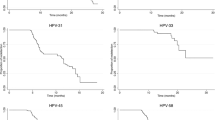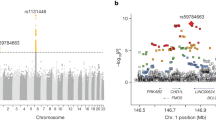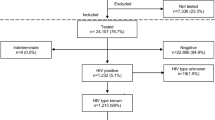Abstract
Two CCL3 haplotypes (HapA1 and Hap-A3) and two polymorphic positions shared by the haplotypes (Hap-2SNP (single nucleotide polymorphism)) were investigated together with CCL3L copy number (CN), for their role in HIV-1 disease. Hap-A1 was associated with protection from in utero HIV-1 infection: exposed uninfected (EU) infants had higher representation of wild type (WT)/Hap-A1 than infected infants (excluding intrapartum (IP)-infected infants), which maintained significance post maternal Nevirapine (mNVP) and viral load (MVL) correction (P=0.04; odds ratio (OR)=0.33). Mother–infant pair analyses showed the protective effect of Hap-A1 is dependent on its presence in the infant. Hap-A3 was associated with increased IP transmission: WT/Hap-A3 was increased in IP-transmitting vs non-transmitting (NT) mothers, and remained significant post mNVP and MVL correction (P=0.02; OR=3.50). This deleterious effect of Hap-A3 seemed dependent on its presence in the mother. Hap-2SNP was associated with lower CD4 count in the NT mothers (P=0.03). CCL3 Hap-A1 was associated with high CCL3L CN in total (P=0.001) and EU infants (P=0.006); the effect was not additive, however, having either Hap-A1 or high CCL3L CN was more significantly (P=0.0008) associated with protection from in utero infection than Hap-A1 (P=0.028) or high CCL3L CN (P=0.002) alone. Linkage disequilibrium between Hap-A1 and high CCL3L CN appears unlikely given that a Nigerian population showed an opposite relationship.
This is a preview of subscription content, access via your institution
Access options
Subscribe to this journal
Receive 6 digital issues and online access to articles
$119.00 per year
only $19.83 per issue
Buy this article
- Purchase on Springer Link
- Instant access to full article PDF
Prices may be subject to local taxes which are calculated during checkout


Similar content being viewed by others
References
Colobran R, Pujol-Borrell R, Armengol MP, Juan M . The chemokine network. I. How the genomic organization of chemokines contains clues for deciphering their functional complexity. Clin Exp Immunol 2007; 148: 208–217.
Cocchi F, DeVico AL, Garzino-Demo A, Arya SK, Gallo RC, Lusso P . Identification of RANTES, MIP-1 alpha, and MIP-1 beta as the major HIV-suppressive factors produced by CD8+ T cells. Science 1995; 270: 1811–1815.
Feng Y, Broder CC, Kennedy PE, Berger EA . HIV-1 entry cofactor: functional cDNA cloning of a seven-transmembrane, G protein-coupled receptor. Science 1996; 272: 872–877.
Gauduin MC, Glickman RL, Means R, Johnson RP . Inhibition of simian immunodeficiency virus (SIV) replication by CD8(+) T lymphocytes from macaques immunized with live attenuated SIV. J Virol 1998; 72: 6315–6324.
Mackewicz CE, Barker E, Levy JA . Role of beta-chemokines in suppressing HIV replication. Science 1996; 274: 1393–1395.
Alkhatib G, Locati M, Kennedy PE, Murphy PM, Berger EA . HIV-1 coreceptor activity of CCR5 and its inhibition by chemokines: independence from G protein signaling and importance of coreceptor downmodulation. Virology 1997; 234: 340–348.
Colobran R, Pujol-Borrell R, Armengol MP, Juan M . The chemokine network. II. On how polymorphisms and alternative splicing increase the number of molecular species and configure intricate patterns of disease susceptibility. Clin Exp Immunol 2007; 150: 1–12.
Hirashima M, Ono T, Nakao M, Nishi H, Kimura A, Nomiyama H et al. Nucleotide sequence of the third cytokine LD78 gene and mapping of all three LD78 gene loci to human chromosome 17. DNA Seq 1992; 3: 203–212.
Nakao M, Nomiyama H, Shimada K . Structures of human genes coding for cytokine LD78 and their expression. Mol Cell Biol 1990; 10: 3646–3658.
Shostakovich-Koretskaya L, Catano G, Chykarenko ZA, He W, Gornalusse G, Mummidi S et al. Combinatorial content of CCL3L and CCL4L gene copy numbers influence HIV-AIDS susceptibility in Ukrainian children. AIDS 2009; 23: 679–688.
Gonzalez E, Kulkarni H, Bolivar H, Mangano A, Sanchez R, Catano G et al. The influence of CCL3L1 gene-containing segmental duplications on HIV-1/AIDS susceptibility. Science 2005; 307: 1434–1440.
Townson JR, Barcellos LF, Nibbs RJ . Gene copy number regulates the production of the human chemokine CCL3-L1. Eur J Immunol 2002; 32: 3016–3026.
Aquaro S, Menten P, Struyf S, Proost P, Van Damme J, De Clercq E et al. The LD78beta isoform of MIP-1alpha is the most potent CC-chemokine in inhibiting CCR5-dependent human immunodeficiency virus type 1 replication in human macrophages. J Virol 2001; 75: 4402–4406.
Menten P, Struyf S, Schutyser E, Wuyts A, De Clercq E, Schols D et al. The LD78beta isoform of MIP-1alpha is the most potent CCR5 agonist and HIV-1-inhibiting chemokine. J Clin Invest 1999; 104: R1–R5.
Liu S, Yao L, Ding D, Zhu H . CCL3L1 copy number variation and susceptibility to HIV-1 infection: a meta-analysis. PLoS One 2010; 5: e15778.
Gonzalez E, Dhanda R, Bamshad M, Mummidi S, Geevarghese R, Catano G et al. Global survey of genetic variation in CCR5, RANTES, and MIP-1alpha: impact on the epidemiology of the HIV-1 pandemic. Proc Natl Acad Sci USA 2001; 98: 5199–5204.
Modi WS, Lautenberger J, An P, Scott K, Goedert JJ, Kirk GD et al. Genetic variation in the CCL18-CCL3-CCL4 chemokine gene cluster influences HIV Type 1 transmission and AIDS disease progression. Am J Hum Genet 2006; 79: 120–128.
Shrestha S, Strathdee SA, Galai N, Oleksyk T, Fallin MD, Mehta S et al. Behavioral risk exposure and host genetics of susceptibility to HIV-1 infection. J Infect Dis 2006; 193: 16–26.
Paximadis M, Mohanlal N, Gray GE, Kuhn L, Tiemessen CT . Identification of new variants within the two functional genes CCL3 and CCL3L encoding the CCL3 (MIP-1alpha) chemokine: implications for HIV-1 infection. Int J Immunogenet 2009; 36: 21–32.
Clark AG . The role of haplotypes in candidate gene studies. Genet Epidemiol 2004; 27: 321–333.
Hu L, Song W, Brill I, Mulenga J, Allen S, Hunter E et al. Genetic variations and heterosexual HIV-1 infection: analysis of clustered genes encoding CC-motif chemokine ligands. Genes Immun 2012; 13: 202–205.
Kuhn L, Schramm DB, Donninger S, Meddows-Taylor S, Coovadia AH, Sherman GG et al. African infants’ CCL3 gene copies influence perinatal HIV transmission in the absence of maternal nevirapine. AIDS 2007; 21: 1753–1761.
Campbell CD, Sampas N, Tsalenko A, Sudmant PH, Kidd JM, Malig M et al. Population-genetic properties of differentiated human copy-number polymorphisms. Am J Hum Genet 2011; 88: 317–332.
Lehner T, Wang Y, Cranage M, Tao L, Mitchell E, Bravery C et al. Up-regulation of beta-chemokines and down-modulation of CCR5 co-receptors inhibit simian immunodeficiency virus transmission in non-human primates. Immunology 2000; 99: 569–577.
Lietz R, Bayer W, Ontikatze T, Johrden L, Tenbusch M, Bonsmann MS et al. Codelivery of the chemokine CCL3 by an adenovirus-based vaccine improves protection from retrovirus infection. J Virol 2012; 86: 1706–1716.
Lu Y, Xin KQ, Hamajima K, Tsuji T, Aoki I, Yang J et al. Macrophage inflammatory protein-1alpha (MIP-1alpha) expression plasmid enhances DNA vaccine-induced immune response against HIV-1. Clin Exp Immunol 1999; 115: 335–341.
Zhao W, Pahar B, Borda JT, Alvarez X, Sestak K . A decline in CCL3-5 chemokine gene expression during primary simian-human immunodeficiency virus infection. PLoS One 2007; 2: e726.
Huik K, Sadam M, Karki T, Avi R, Krispin T, Paap P et al. CCL3L1 copy number is a strong genetic determinant of HIV seropositivity in Caucasian intravenous drug users. J Infect Dis 2010; 201: 730–739.
Meddows-Taylor S, Donninger SL, Paximadis M, Schramm DB, Anthony FS, Gray GE et al. Reduced ability of newborns to produce CCL3 is associated with increased susceptibility to perinatal human immunodeficiency virus 1 transmission. J Gen Virol 2006; 87 (Pt 7): 2055–2065.
Nakajima T, Ohtani H, Naruse T, Shibata H, Mimaya JI, Terunuma H et al. Copy number variations of CCL3L1 and long-term prognosis of HIV-1 infection in asymptomatic HIV-infected Japanese with hemophilia. Immunogenetics 2007; 59: 793–798.
Shalekoff S, Meddows-Taylor S, Schramm DB, Donninger SL, Gray GE, Sherman GG et al. Host CCL3L1 gene copy number in relation to HIV-1-specific CD4+ and CD8+ T-cell responses and viral load in South African women. J Acquir Immune Defic Syndr 2008; 48: 245–254.
Dolan MJ, Kulkarni H, Camargo JF, He W, Smith A, Anaya JM et al. CCL3L1 and CCR5 influence cell-mediated immunity and affect HIV-AIDS pathogenesis via viral entry-independent mechanisms. Nat Immunol 2007; 8: 1324–1336.
Carpenter D, McIntosh RS, Pleass RJ, Armour JA . Functional effects of CCL3L1 copy number. Genes Immun 2012; 13: 374–379.
Redon R, Ishikawa S, Fitch KR, Feuk L, Perry GH, Andrews TD et al. Global variation in copy number in the human genome. Nature 2006; 444: 444–454.
McCarroll SA, Kuruvilla FG, Korn JM, Cawley S, Nemesh J, Wysoker A et al. Integrated detection and population-genetic analysis of SNPs and copy number variation. Nat Genet 2008; 40: 1166–1174.
Locke DP, Sharp AJ, McCarroll SA, McGrath SD, Newman TL, Cheng Z et al. Linkage disequilibrium and heritability of copy-number polymorphisms within duplicated regions of the human genome. Am J Hum Genet 2006; 79: 275–290.
Conrad DF, Pinto D, Redon R, Feuk L, Gokcumen O, Zhang Y et al. Origins and functional impact of copy number variation in the human genome. Nature 2010; 464: 704–712.
Lewontin RC . The interaction of selection and linkage. I. General considerations; heterotic models. Genetics 1964; 49: 49–67.
Liau SW, Mickey R, Romano P, Lee TD . Study of the HLA system in the Haitian population. Tissue Antigen 1984; 23: 308–313.
Guo SW, Thompson EA . Performing the exact test of Hardy-Weinberg proportion for multiple alleles. Biometrics 1992; 48: 361–372.
Uitenbroek DG . SISA Binomial. Southampton: D.G. Uitenbroek Retrieved 01 January 2004. http://www.quantitativeskills.com/sisa/distributions/binomial.htm. 1997.
Acknowledgements
This study was supported in part by grants from the South African AIDS Vaccine Initiative, NICHD (HD 42402, HD 36177) and Wellcome Trust (076352/Z/05/Z).
Author information
Authors and Affiliations
Corresponding author
Ethics declarations
Competing interests
The authors declare no conflict of interest.
Additional information
Supplementary Information accompanies the paper on Genes and Immunity website
Supplementary information
Rights and permissions
About this article
Cite this article
Paximadis, M., Schramm, D., Gray, G. et al. Influence of intragenic CCL3 haplotypes and CCL3L copy number in HIV-1 infection in a sub-Saharan African population. Genes Immun 14, 42–51 (2013). https://doi.org/10.1038/gene.2012.51
Received:
Revised:
Accepted:
Published:
Issue Date:
DOI: https://doi.org/10.1038/gene.2012.51



